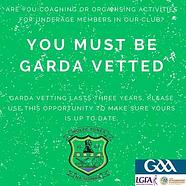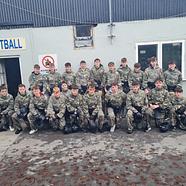According to the GAA Coach Education Programme, a coachis a “person that builds competency by assisting and challenging players to achieve their full potential.” There are many things we do consciously (aware of our actions) and sub-consciously (unaware of our actions) as coaches – actions that can be beneficial and/or detrimental for player development. Unfortunately there is no gold standard or fool-proof method of coaching – the best way to learn is by getting involved with a team, which will involve various successes and failures. We could choose to adopt an effective coaching practice such as the “6 Steps.”
STEP 1 – BUILD RAPPORT
Coaches mentoring underage players are often challenged with socialising issues. Initially a coach may find it difficult to communicate with his/her players; however no blame should be directed towards him/her, as this is simply a protective mechanism used by children. In order for a coach to gain the trust of a child, it is crucial that he/she builds rapport with them. As soon as the coach-child relationship has been established, children’s confidence and competence will begin to grow as they feel valued by their coach. If a coach successfully builds rapport with the whole group; improvements in concentration, team cohesion and behaviour/attitude are witnessed.
Coaches could attempt to build rapport by learning the names of all their players i.e. calling a player by their birth name. Avoiding the use of nicknames, and language like “this boy/girl” or “you over there,” will also contribute to this process. In addition, coaches may learn about players’ other hobbies/interests, through informal chat between activities or during water breaks, as this demonstrates to the child that their coach cares about them. Coaches that speak softly, smile regularly and acknowledge effort (thumbs up/nod/high five) will quickly build rapport with their group of young players.
STEP 2 – PROVIDE DEMONSTRATIONS
Research has indicated that 95% of Irish children are visual learners. A demonstration is much quicker for a coach to execute versus spoken instructions, and it may also prove easier to illustrate (paint an internal picture) their message across to players. Therefore by providing demonstrations, coaches reduce the possibility of a misunderstanding.
In order for players to reap the benefits of the demonstration, it is vital that everybody is able to see and hear the coach. Coaches would like to afford young players with the best opportunity to visualise the skill, so it is also recommended to provide demonstrations from numerous viewpoints. The coach will attempt to demonstrate the skill/action to the highest standard (technically proficient), as this may inspire children to experiment during their own practice, and are less likely to inherit bad habits due to the clarity of the coach’s performance. If a coach is unable to perform a specific skill, they can simply ask one of their skilled players to demonstrate it for others – this is referred to as “peer-to-peer learning.”
STEP 3 – EXPLAIN
The purpose of an explanation is to further develop players’ understanding of a skill or game scenario. However coaches must be cautious when speaking to their group of players; not to undo the benefit of witnessing a demonstration. Players become easily distracted and confused with long winded discussions.
Coaches are advised to gain the attention of their players beforehand, especially for those coaching children who have a short attention-span. It is no use if only some players hear the explanation, and others don’t due to unnecessary chatter. It is also recommended that coaches have a plan of what they wish to explain prior to speaking. Coaches should use appropriate language, orientated towards their group of players e.g. concise and basic language is advised when coaching younger players. Children may not yet appreciate or understand complicated words and phrases, so “keep it simple!” A series of short questions are also effective to check for players’ understanding prior to implementing the activity.
STEP 4 – OBSERVE
Observation allows coaches to identify those who need further challenge (skilled players), and those who need assistance (developing players). It also enables a coach to evaluate the effectiveness of the activity, by closely watching the body language and/or facial expressions of the players, and if intervention is needed i.e. progression/regression of the skill or game.
Coaches receive visual feedback from several angles – standing in one position doesn’t permit a coach to do so. It’s important to observe each player numerous times, while focusing on a single body region at any one time e.g. head, hands, hurley/ball, feet. A coach may also utilise their ears to gain aural feedback (where appropriate) during technical sessions e.g. wall alley, free taking. This feedback can be particularly useful if a coach is working on kicking/striking consistency i.e. a mishit produces a different sound in comparison to a correctly executed kick or strike.
STEP 5 – ANALYSE AND MAKE DECISIONS
Without analysis the developmental pathway of a player stagnates (level-off), and eventually leads to regression (worsens over time). If coaches don’t make decisions based on their observations during training sessions and matches, they are failing to fulfil their duty i.e. neglecting the needs of their players. Although sometimes we are guilty of “over-coaching” our players by trying to find faults when they may not be present – instead we could use the following decision-making process.
When watching a child play coaches could attempt to compare their observations with their own visual interpretation of “good practice.” This allows a coach to identify the matching and mismatching elements regarding optimal performance of the skill. Every skill in Gaelic games has approximately 4-6 key coaching points; so as coaches analyse its performance they can determine if these points are adhered. Coaches are then required to make a decision – (a) re-enforce the key coaching points; (b) modify the activity; or (c) make a “mental note” but take no immediate action. Sometimes we feel obliged to intervene when a child is struggling with a skill or game scenario, but occasionally the best protocol is to allow the child to experiment and self-learn.
STEP 6 – GENERATE AND PROVIDE FEEDBACK
The traditional method of teaching (coaching in sport) has involved one person speaking to another group of people, and telling them everything they need to know about a given topic. However this method has become outdated as we are now aware that people learn differently e.g. visual, aural, verbal, kinaesthetic, etc. Therefore within a squad of players you are guaranteed to have a variety of learning styles.
Providing feedback during training sessions and matches is needed to verify understanding, otherwise players could be totally unaware of potential improvements. It is recommended that coaches choose to generate feedback through questioning, instead of giving players the required information (answers). The generation of feedback is an effective method of developing awareness and self-analysis; while also keeping the session orientated towards the player – not the coach.
FINAL THOUGHT
It is estimated that 50,000 coaches are required to volunteer their time, effort and resources on any given weekend in order for matches and training sessions to take place; therefore coaches have an integral role in the development and promotion of Gaelic games. An appreciation of the “6 Steps” coaching approach, as outlined above, may help coaches to build on existing knowledge (from playing/coaching experience), leading to an overall improvement in coaching standards, thus increasing the likelihood of our players reaching their full potential!







